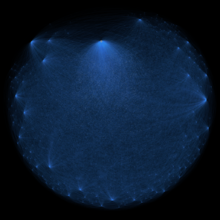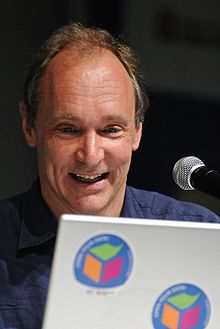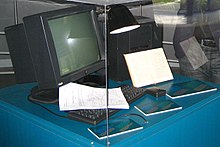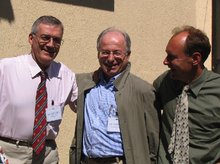World Wide Web
![]()
Web and WWW are redirects to this article. For other meanings, see Web (disambiguation) and WWW (disambiguation).
The World Wide Web [ˌwɜːldˌwaɪdˈwɛb] ( ![]() ) (English for "worldwide web", short Web, WWW, rarely and especially in the early days and the USA also W3) is a system of electronic hypertext documents, so-called web pages, which can be accessed via the Internet and which are described with HTML. They are linked to each other by hyperlinks and are transmitted on the Internet via the HTTP or HTTPS protocols. The web pages usually contain text, often illustrated with images and graphic elements. Videos, sound documents or pieces of music are also frequently embedded.
) (English for "worldwide web", short Web, WWW, rarely and especially in the early days and the USA also W3) is a system of electronic hypertext documents, so-called web pages, which can be accessed via the Internet and which are described with HTML. They are linked to each other by hyperlinks and are transmitted on the Internet via the HTTP or HTTPS protocols. The web pages usually contain text, often illustrated with images and graphic elements. Videos, sound documents or pieces of music are also frequently embedded.

Visualization of the World Wide Web Common Crawl from 2012 (44 million domains).

The historic WWW logo, designed by Robert Cailliau

Graphical representation of some web presences in the World Wide Web around en.wikipedia.org in July 2004
General
Colloquially, the World Wide Web is often equated with the Internet, but it is younger and represents only one of several possible uses of the Internet. Other Internet services such as e-mail, IRC or SSH are not integrated into the World Wide Web.
To access content from the World Wide Web, a web browser is required, e.g. running on a PC or a smartphone. It allows the user to download the data provided on any web server they choose and display it on a suitable output device such as a screen or Braille display. The user can then follow hyperlinks on the displayed web page that point to other web pages, whether they are stored on the same web server or on a different one. This results in a worldwide network of web pages. Following the hyperlinks is also called "surfing the Internet".
With the so-called Web 2.0, websites became popular from around the 2000s onwards whose content the user can not only passively view, as is the case with news sites, but can also change and add to themselves, e.g. in order to publish their own content or to communicate with other users. These include blogs as private opinion pages, pages created by a loose community of authors according to the Wiki principle, and social networks such as forums. Server-side techniques and (scripting) languages that implement this interactivity are primarily CGI, Python, ASP, Apache Wicket, JSF, ColdFusion, Ruby, PHP, and SSI. Client-side techniques that use filters, for example, to individualize content include CSS, JavaScript, or Java, with Java mainly used for platform-neutral execution of programs that are often loaded as Web applications over the Internet and communicate with Internet-based databases (e.g., SAP clients). With interactivity, the use of search engines became possible, which supplemented the previously existing web directories and have largely supplanted them to this day.
With the increasing complexity of formats, protocols and techniques, new job profiles emerged, such as web designers and mediamaticians. In addition to programming content, their tasks also include the evaluation of user behavior in the context of log file analysis.
The WWW was developed by Tim Berners-Lee and Robert Cailliau at the European research center CERN in Geneva in 1989, further developing known similar concepts. Berners-Lee developed the HTTP network protocol and the HTML text markup language. He also programmed the first web browser and the first web server software. He also operated the world's first web server on his NeXTcube development computer. The overall concept was made freely available to the public in 1991 without any patenting or royalty payments, which contributed significantly to its importance today.
The world's first website info.cern.ch was published on 6 August 1991. A replica of this page can be reached via the following link:
- info.cern.ch
The WWW led to comprehensive upheavals in many areas of life, often described as revolutionary, to the emergence of new branches of industry and to a fundamental change in communication behaviour and media use. In terms of its cultural significance, together with other Internet services such as e-mail, it is sometimes equated with the invention of printing.
History
Development
The Web originated in 1989 as a project at the research facility CERN, located near Geneva on Swiss and French territory, where Tim Berners-Lee built a hypertext system. He first presented the idea at the research facility on March 12, 1989. The concept was co-designed by the Belgian Robert Cailliau. The original aim of the system was to share research results with colleagues in a simple way. One method for doing this was to "interweave" scientific articles - in other words, to create a web. In Berners-Lee's own words:
"The WorldWideWeb (W3) is a wide-area hypermedia information retrieval initiative aiming to give universal access to a large universe of documents."
"The World Wide Web is a large-scale hypermedia initiative for information retrieval with the goal of allowing general access to a large collection of documents."
- Tim Berners-Lee
The concept underlying hypertext derives from earlier developments, such as Ted Nelson's Xanadu project, Vannevar Bush's "memex" machine idea, and the Note Code Project.
The World Wide Web differs from hypertext systems of the time (Note Code, for example, used simple and readable syntax and semantic descriptors). The WWW requires only unidirectional links instead of bidirectional ones, which makes it possible to link to a resource without the need for its owner to intervene. In addition, unlike other protocols such as HyperCard or Gopher, the World Wide Web is built on a free protocol, which made it possible to develop servers and clients without restrictions imposed by licenses. Tim Berners-Lee made the World Wide Web project publicly and globally available on August 6, 1991 with a contribution to the newsgroup alt.hypertext.
The first Web display program, which was more of a browser-editor hybrid, was simply called "WorldWideWeb" by Berners-Lee. He had written it in the fall of 1990 on a NeXT computer. Later, to avoid confusion with the World Wide Web (with spaces), he renamed it "Nexus." It could only display text at the time, but later browsers such as Pei Weis Viola (1992) added the ability to display graphics. Marc Andreessen of NCSA released a browser called "Mosaic for X" in 1993, which soon brought unprecedented popularity to the Web, and indeed to the Internet as a whole, beyond its previous user base and explosive growth. Marc Andreessen founded the company "Mosaic Communications Corporation", later "Netscape Communication". Meanwhile, modern browsers can also play additional features such as dynamic content, music, animation and video. On April 30, 1993, the board of directors of the European nuclear research center CERN released the World Wide Web to the public free of charge.
Name
In Berners-Lee's first project draft from March 1989, the web was still called Mesh. The name was quickly discarded, however, as it was too reminiscent of Mess. The following attempts to name the project Mine of Information or The Information Mine were not successful, because the abbreviations MOI (French I) and TIM seemed too egocentric. Moreover, a mine was only a partially suitable image, since one can merely get something out of it, whereas the Web should both provide information and be filled with it.
Eventually Berners-Lee settled on Web and World Wide Web (based on the term World Wide Wireless coined in the early 20th century for the then emerging worldwide radio communication), although he was warned by colleagues that the tongue-twisting abbreviation WWW in English and French would endanger the success of the project. Web seemed particularly appropriate to him as an image, since in mathematics it denotes a network of nodes, any one of which can be connected to any other.

Tim Berners-Lee, 2009

First web server by Tim Berners-Lee

Robert Cailliau, Jean-François Abramatic and Tim Berners-Lee on the 10th anniversary of the World Wide Web Consortium
Search within the encyclopedia